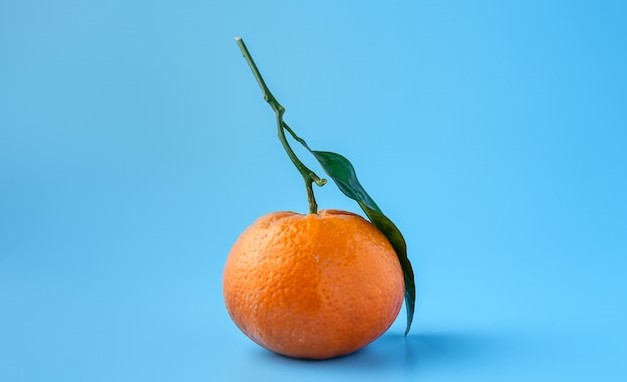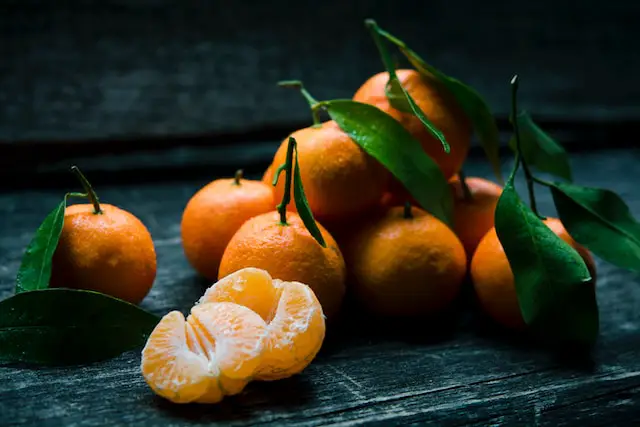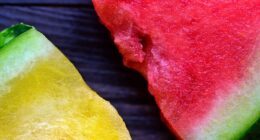Tangerines are generally larger and have a more complex flavor profile with hints of sweetness, sourness, and bitterness. Mandarins are smaller and sweeter with a simpler flavor.Both fruits offer numerous health benefits due to their high vitamin C content
Tangerine
(Photo by Mae Mu on Unsplash )

Tangerines are a type of citrus fruit that belong to the same family as oranges and clementines. They are smaller in size compared to oranges, with a bright orange-red color that is easy to spot. Tangerine skins are typically thin and easy to peel, which makes them a convenient snack on-the-go.
One of the main differences between tangerines and other citrus fruits is their shape. Unlike round oranges or oblong grapefruits, tangerines have a slightly flattened appearance with a pronounced “nose” at one end. This unique shape has earned them the nickname “zipper fruit” due to how easily they can be peeled.
Tangerines also have an incredibly distinct taste profile when compared to other citrus fruits. They are known for being sweet and tangy with hints of acidity, making them perfect for snacking or incorporating into desserts like cakes and pies.
In terms of nutritional value, tangerines are rich in vitamin C which helps boost immunity and promote healthy skin. They also contain fiber which aids digestion and lowers cholesterol levels.
Tangerines may seem small but they pack quite a punch when it comes to flavor and nutrition!
Mandarin
(Photo by Jonathan Pielmayer on Unsplash )

Mandarins are small citrus fruits that are sweet and easy to peel. They originated in China, where they were a symbol of good luck and fortune. Mandarins are also known as mandarin oranges or simply “mandarins,” depending on the region.
Mandarins have thin, smooth skin that is usually bright orange in color. The flesh inside can range from pale yellow to deep orange, depending on the variety. Unlike some other citrus fruits, mandarins do not have seeds (or only a few), which makes them easier to eat.
One of the most common types of mandarin is the clementine, which has become popular around Christmas time as a healthy snack and stocking stuffer. Other types include satsumas and tangerines, which are often confused with each other due to their similar appearance.
Mandarins are rich in vitamin C and antioxidants like beta-carotene that protect against inflammation and chronic disease. They also contain fiber, potassium, folate, thiamin (vitamin B1), calcium and magnesium—all important nutrients for overall health.
In addition to being eaten fresh or used in salads or desserts, mandarins can be juiced or turned into marmalade or preserves. Their fragrant zest can also be added to recipes for extra flavor without adding calories or fat
Tangerine Vs. Mandarin – Key differences
While tangerines and mandarins are both citrus fruits that belong to the same family, there are a few key differences between the two. Firstly, the appearance of these two fruits differs slightly – tangerines tend to be larger than mandarins and have a more orange-red color, while mandarins have a brighter orange hue.
Secondly, when it comes to taste, tangerines are typically sweeter with a stronger flavor profile compared to their milder tasting counterpart. Mandarins also tend to be easier to peel due to their looser skin compared to tangerines.
In terms of nutritional value, both fruits offer similar benefits as they are high in vitamin C and other essential nutrients such as dietary fiber. However, some studies suggest that tangerine peels may contain higher levels of antioxidants compared to mandarin peels.
If you’re wondering whether Cuties (the popular snack-size fruit) is a type of mandarin or tangerine – it’s actually both! Cuties can refer to either variety depending on the season and location in which they were grown.
While there may not be drastic differences between these two citrus fruits, understanding them can help you appreciate their unique qualities better.
How to incorporate tangerines and mandarins into your diet
If you’re looking for a sweet and healthy snack, tangerines and mandarins are great options to incorporate into your diet. Here are some easy ways to add them in:
- As a standalone snack: Simply peel the fruit and enjoy it as is! Tangerines and mandarins make an ideal snack since they’re portable, easy to eat, low in calories but high in fiber.
- In salads: Slice tangerine or mandarin segments onto a bed of greens with other fruits such as pomegranate seeds or strawberries for added nutrition, flavor, texture.
- In smoothies: Add peeled tangerine or mandarin segments into your blender when making smoothies along with other fruits like banana, berries or apple slices.
- As a marinade: Mix orange juice (tangerines work well here) with olive oil and herbs like thyme or rosemary to create flavorful marinades for chicken, fish or tofu dishes.
- On top of yogurt: Add sliced tangerine or mandarin sections on top of plain Greek yogurt for an extra burst of vitamin C in the morning breakfast routine!
Try incorporating these tasty citrus fruits into your diet today!
The difference in appearance between tangerines and mandarins
Tangerines and mandarins are two citrus fruits that look quite similar to each other. However, there are some key differences in their appearance. Tangerines are usually slightly larger than mandarins, with a more orange color and a pebbly texture on the skin. The shape of tangerines is also typically flatter than mandarins.
Mandarins, on the other hand, have a reddish-orange color and smoother skin than tangerines. They tend to be smaller in size compared to tangerines and have a rounder shape with a characteristic bump or knob at the top of the fruit.
When you cut open these fruits, you can also observe some differences between them. Tangerine flesh is often darker orange compared to mandarin flesh which appears lighter in color. Additionally, tangerine seeds tend to be larger than those found inside mandarins.
While both fruits may appear relatively alike at first glance; they do have subtle differences worth noting when selecting your preferred citrus snack or ingredient for your next recipe!
The difference in taste between tangerines and mandarins
When it comes to taste, tangerines and mandarins are similar in many ways but have some slight differences. Tangerines are generally sweeter than mandarins, with a more pronounced tangy flavor. They also tend to be juicier and have a slightly thicker skin.
Mandarins, on the other hand, have a milder sweetness with less tartness than tangerines. They often have a thinner skin that is easier to peel and can be slightly more aromatic than tangerines.
One of the key factors influencing taste differences between these two citrus fruits is their respective levels of acidity. Tangerines typically contain higher levels of acid which contributes to their tangy taste while mandarins contain less acid resulting in their milder flavor profile.
When consuming either fruit as fresh whole fruit or juice, you will notice how juicy they are with hints of sweetness and tartness throughout each bite or sip.
Whether you prefer your citrus sweet or mild-tasting – both tangerines and mandarins offer an array of flavors that make them deliciously unique!
The difference in nutritional value between tangerines and mandarins
When it comes to the nutritional value of tangerines and mandarins, they are quite similar. Both fruits are known for being low in calories but high in essential vitamins and minerals.
For instance, both tangerines and mandarins contain vitamin C, which is an antioxidant that helps boost the immune system while also promoting healthy skin. Additionally, these citrus fruits contain potassium, a mineral that plays a vital role in regulating blood pressure levels.
One key difference between tangerines and mandarins is their fiber content. Tangerines tend to have slightly more fiber than mandarins due to their thicker peels. Fiber is important for digestive health as it promotes regular bowel movements and can even help lower cholesterol levels.
Another notable difference between these two fruits is their acidity level. Tangerines tend to be sweeter with less acidity compared to mandarins which can vary from sweet-tart to very tangy depending on the variety.
Whether you choose tangerines or mandarins for your daily intake of nutrients largely depends on personal taste preferences and availability at your local grocery store or farmer’s market.
Are cuties mandarins or tangerines?
Cuties are actually a brand name for a specific type of mandarin, known as Clementine mandarins. So to answer the question directly, cuties are not tangerines but rather a specific variety of mandarin.
Clementine mandarins were first discovered in Algeria in 1902 and were later introduced to the United States in 1914. They have since become one of the most popular types of mandarins due to their easy-to-peel skin and sweet taste.
Cuties are smaller than traditional oranges and have thin, smooth skin that is easy to peel by hand. The fruit inside is seedless and has a juicy texture with a slightly sweeter taste than other types of oranges.
While tangerines and clementine mandarins may look similar on the outside, they do have distinct differences in their flavor profile and nutritional content. It’s important to know exactly what you’re buying when it comes to these citrus fruits so that you can choose which best suits your needs.
Featured Image By – Sahand Babali on Unsplash








